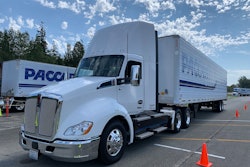The fully electric truck may feel like it's a couple battery iterations away from mass production, but the electrification of existing parts of a conventional driveline is the technology of today. Granted, the goals here are markedly different. One is a planet-saving zero-emission vehicle, the other – in this case Mack Trucks' Command Steer – takes aim at driver comfort and safety.
Command Steer, an electrically-assisted hydraulic steering system, has been available on certain Mack Models since 2020. It adds an electric motor to the existing hydraulic steering system to reduce manual steering input from the driver by up to 85%, and reduces driver fatigue and muscle strain by up to 30% by providing nearly 11 pounds of steering assist. The short version: it gives steering a light feel.
"This is similar to when we started having power steering... the fact that it takes so much feedback from the road – the wear and tear – out of your arms, your neck, your shoulders and head." said Jonathan Randall, Mack Trucks senior vice president.
I took a pair of Mack Granites – one equipped with Command Steer and one without – through mid-Atlantic construction giant H&K Group's Easton Quarry and Asphalt plant, and the effectiveness of the optional upfit couldn't have been more obvious.
A quarry is a violent place to drive – especially a loaded with 40,000 pounds of rock – but it's everyday life for thousands of drivers. Without Command Steer, the truck is heavy and rams its way across the jobsite. You feel every pothole in every inch of your body. Driving through tight S-curves, sawing back and forth on the wheel, is an upper body workout.
Command Steer not only takes head-on all that work and abuse, it keeps the truck on course; something I struggled with manually while bouncing all over the cab. Multiple sensors throughout the truck monitor road condition and driver input and relay those observations more than 2,000 times per second, and based on the data collected the system provides variable steering effort through the electric motor, applying additional torque as needed to make it easier to keep the truck on the intended route.
Hitting a deep pothole or driving off the shoulder, it's inevitable that the truck will turn itself based on the forces applied to the tire. Command Steer sensors can recognize the difference from when the driver wants to go left, for example, versus being jostled left, seeing that the input to move the tires either did or didn't come from the correct place – the steering wheel – and react accordingly. Command Steer won't stop you from bouncing around the cab like the pea in a can of spray paint, but it will remove the influence that has on the vehicle's line of travel.










